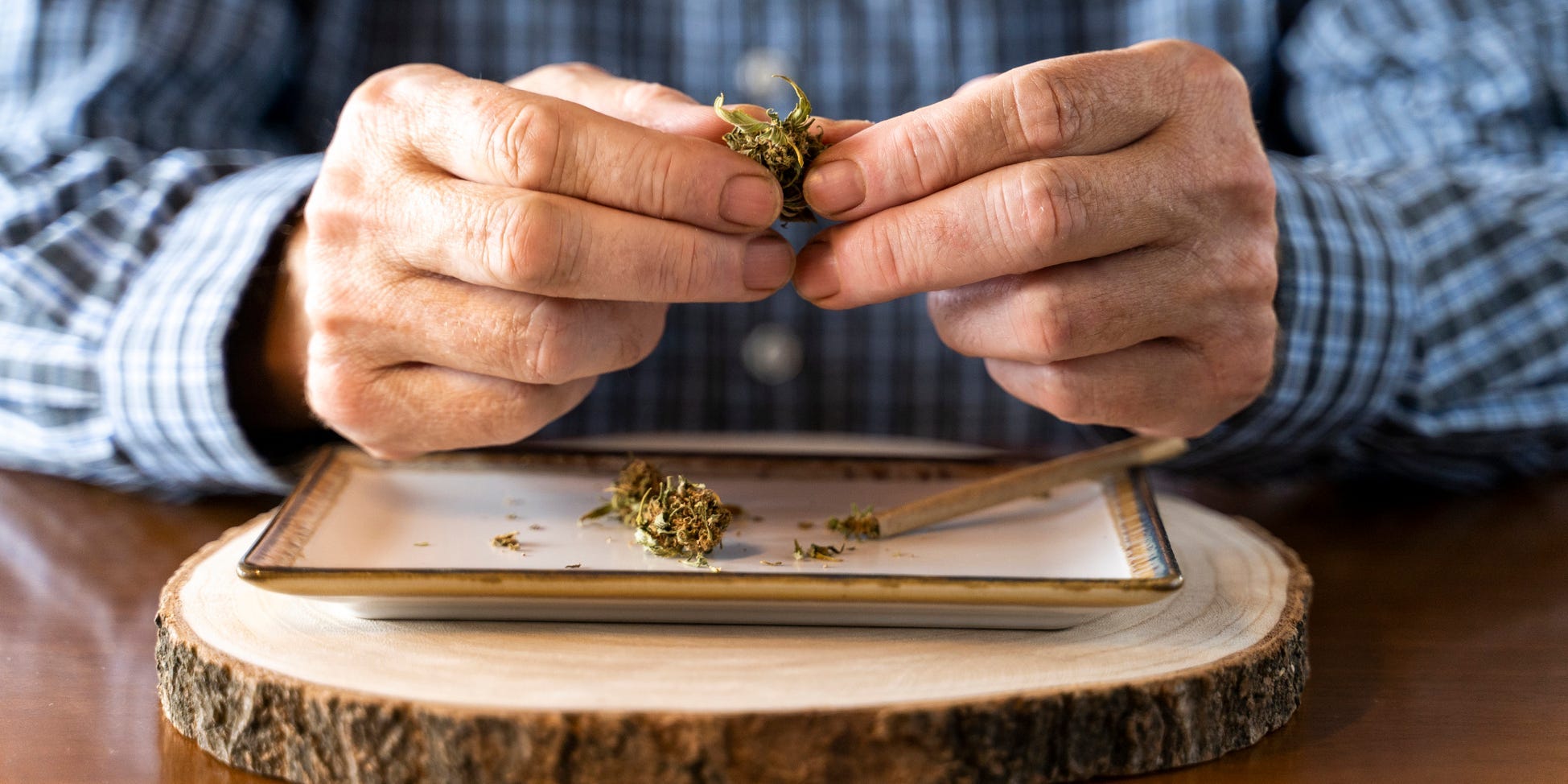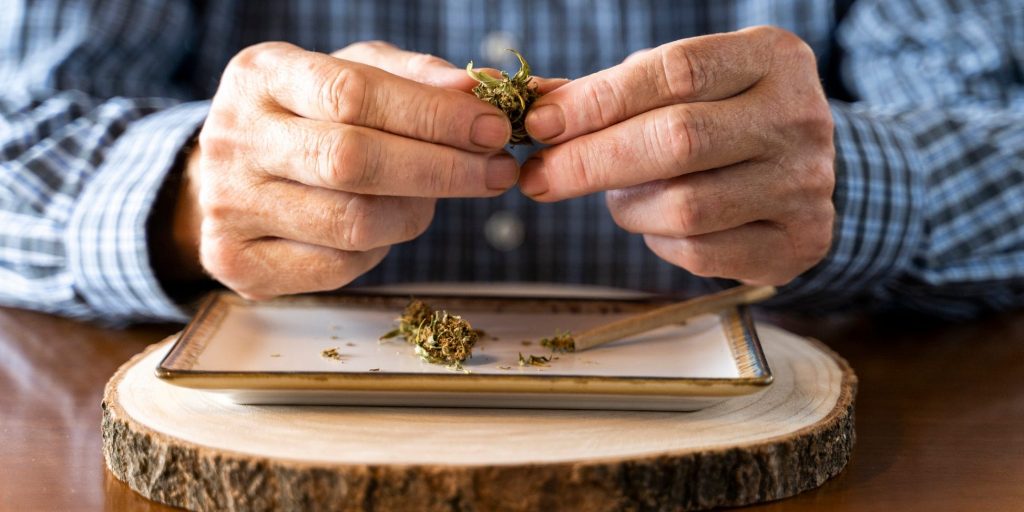
Westend61/Getty Images
- Medical marijuana differs from recreational weed as it is formulated to treat certain conditions.
- Medical marijuana can be used for managing symptoms of anxiety, insomnia, chronic pain, and nausea.
- To get a medical marijuana card, contact a primary care physician or a medical marijuana clinician.
- Visit Insider's Health Reference library for more advice.
While marijuana remains federally illegal, a growing number of states have legalized medical marijuana for relief from conditions like Crohn's disease, insomnia, and glaucoma.
In fact, millions of Americans across 36 states and 4 territories are legally registered to use medical marijuana.
If you're interested in using medical marijuana, here's your how-to, comprehensive guide.
What is medical marijuana?
Medical marijuana refers to cannabis products that are specifically formulated or marketed to relieve symptoms of various medical conditions.
The formula is usually a specialized combination of CBD, THC, and other natural pain-relieving chemicals found in marijuana, says Laszlo Mechtler, MD, the Medical Director of Dent Neurologic Institute and Medical Advisor at Jushi Holdings, Inc.
That's what differentiates medical marijuana from recreational: Recreational marijuana typically contains more THC - the chemical that gets you high. Additionally, Mechtler says products purchased through your state's medical program are more likely than recreational marijuana to be screened for contaminants like pesticides, heavy metals, bacteria, and fungus.
How to use medical marijuana
If your doctor determines that you might benefit from medical marijuana, they along with a dispensary pharmacist will work with you to determine the ideal product, formulation, and dosage based on your symptoms and needs, Mehtler says.
When determining what marijuana products a patient should use, Mechtler says there are several important questions to consider:
- How fast does the product work?
- What are the side effects and interactions with drugs you may be on?
- How long does it last?
The answers to the above questions will help you and your physician figure out what form of cannabis you should take, whether it's long-lasting edibles or fast-acting flower. Here are some of the most common medical marijuana products and how they work:
- Dried flower: Dried flower consumed through vaping or smoking is fast-acting and helpful for people who need quick relief from anxiety or panic attacks, Mechtler says.
- Oil: Oil products are also fast-acting, Mechtler says, and an option for people who need quick relief but may not want to smoke.
- Edibles (candies, drinks, lozenges): Edibles take longer to kick in and can last 4 to 6 hours, making them a good option for people with chronic pain, Mechtler says.
- Tinctures: Tinctures are highly concentrated extracts that are quickly absorbed under the tongue, making them a good option for people who need quick relief.
- Topicals (balms, ointments, creams): These treatments are applied directly to the skin to relieve pain related to the skin or nerves.
- Capsules: Capsules, like edibles, take time to kick in but can last for many hours, Mechtler says.
In addition to how fast the effects kick in and how long they last, it's also important to consider how taking medical marijuana will fit into your daily life.
"Sometimes patients don't want to smoke because they don't want to have their kids, or parents or neighbors see them smoke," says Erik Smith, MD, a medical practitioner with the cannabis healthcare technology company, Veriheal. "When it comes to choosing what vehicle to use, it's really dependent upon what a patient's individual needs are within their home life, work life, and social life."
Uses of medical marijuana
Medical marijuana is most often used to treat chronic pain, and there is research to back this up. In fact, a large 2015 review found using cannabis increased a patient's chances of pain relief by 40% when compared to control groups. Patients included those with nerve-based pain or pain related to cancer, multiple sclerosis, rheumatoid arthritis, musculoskeletal issues, and chemotherapy-induced pain.
Medical marijuana may also relieve certain symptoms of:
- Anxiety
- Nausea
- Insomnia
- Epilepsy
- Glaucoma
- Relief from HIV/AIDS symptoms
- Multiple Sclerosis (MS)
- Crohn's disease
- Inflammatory Bowel Disease
- PTSD
- Ulcerative Colitis
- Alzheimer's
- Tourette's Syndrome
- Anorexia
How to get a medical marijuana card
In states with medical marijuana programs, you'll need to obtain a medical cannabis card in order to visit a medical dispensary.
Different states have different sets of conditions you must meet in order to qualify for a medical marijuana card. In some states, like New York, you'll also need to register with your state health department, which typically involves some online paperwork.
To get a medical cannabis card, start by talking to your primary care provider. "Most doctors, believe it or not, are open to medical marijuana," Mechtler says. "Your primary care provider can give you advice on what steps to take."
If you don't feel comfortable reaching out to your PCP, Mechtler and Smith encourage patients to research medical marijuana clinicians in their communities and in virtual practices online. These are healthcare providers who are registered to certify patients to receive medical marijuana cards. Websites like Leafly provide databases that can help you locate a specialist.
However, different states have different medical cannabis laws, so you may not always be able to obtain a card. For example, five states - Idaho, Wyoming, Kansas, Tennessee, and South Carolina - do not have medical cannabis programs.
Additionally, some states have medical programs allowing cannabis products containing only CBD, while others allow THC and CBD combinations. You can look up your state's regulations here.
Insider's takeaway
A growing number of patients are turning to medical marijuana to find relief from pain and chronic symptoms. However, when starting any new medication routine, it can take time to find the proper dose and formula that work for you.
"One of the great challenges with cannabis is that everybody responds differently," Smith says. "It's a process of trial and error and it can take four to six weeks for patients to really find their footing and feel results."
